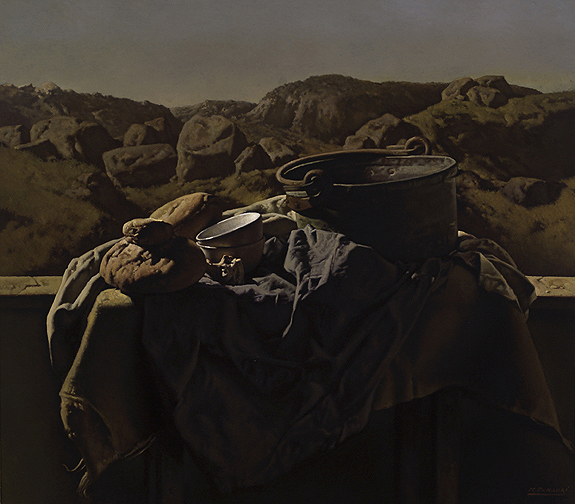Piece of the month June 2009
THE PAINTING CUPS AND BREAD, BY MIGUEL DE ECHAURI, DONATED TO THE MUSEUM OF NAVARRA
Emilio Quintanilla Martínez
Chairof Navarrese Heritage and Art
The Pamplona painter Miguel Echauri has donated to the Museum of Navarra his work entitled Tazas y pan, oil on canvas 115 x cm, on the occasion of the anthological exhibition held at the museum between March and May 2009.
The painting, dated 2002, is a very representative sample of his current style, the result of a maturity reached after a long production and an extensive pictorial experimentation.
We could explain this work by referring to the roots of his painting, which are linked to the teaching of Ciga, with whom he started in this art, to the Spanish baroque betrayal, so close to the tactile representation of surfaces and the ideological charge of the still life of vanitas; to the importance of the expressive value of the subject, closely related to the broad Spanish informalist movement, of whose members Miguel Echauri is a contemporary, or to other historical or aesthetic categories.
But none of them explains the painting as profoundly as the experience of this painting itself, the world of suggestions that the direct contemplation of the canvas transmits and suggests. In it we see, placed on a table in front of a parapet, a series of everyday objects, which can even be called vulgar: some bread, a couple of bowls and a cauldron, arranged on some rough cloths. And behind, a parched stony landscape and a caliginous sky. The colors run through a wide range of ochre and bluish tones. The technique, of a meticulousness that characterizes this author.

Miguel de Echauri. "Cups and bread". 2002
Museum of Navarre
But the mere description of the painting contributes practically nothing to its understanding, since the objects represented and the way in which this is done are but the keys to penetrate into a whole world of suggestions, of invitations to communication; which can awaken in each of those who contemplate it feelings as different as spectators.
Of course, we cannot fail to mention, admiringly, the great mastery of the painter's official document that allows him to capture, with a technique of great virtuosity, and achieving exquisite nuances, the material qualities: the roughness of the fabrics, the qualities of the objects, the gradations in the textures, which, especially in the landscape, allow to establish the spatial evaluation and depth, the lights that lend Issue and timelessness, the aerial perspective.
The meticulous technique, without falling into miniaturism, manages to dignify the humility of the objects represented, and thus, that kind of blanket, surely old and, of course, humble, acquires as many violet shades as a royal mantle; the cauldron, rusty, becomes almost a piece of goldsmithery, dignified by the care taken in its representation; the humble bowls have the brilliance of the best ceramics....
And what can we say about the landscape, perfectly defined spatially, inert, almost lunar, but with the desolate beauty of the desert.
And all this opens the way to communication with the spectator, who is the addressee of the painting, and to whom a univocal vision is not presented. Some will see, as if they were tasting Proust's madeleine, a past world of which these objects are a reference and whose memory is awakened now; others, the passage of time and therefore, the invitation to carpe diem; others the survival of a past that is longed for; there will also be those who see symbols of destruction, the inexorable and destructive action of time, and perhaps there will also be those who experience the invitation to overcome a past world from which little can be taken advantage of.
Or none of the above possibilities, but others, intimate, singular, personal, sensations awakened by the humble objects in the painting.
bibliography
Miguel Echauri's painting has been sufficiently treated by critics over several decades. The best bibliographical compilation, in addition to a rigorous scientific study, is the recent work by Francisco Javier ZUBIAUR CARREÑO, Miguel Echauri, Pintor, Gobierno de Navarra, department de Cultura y Turismo, Institución Príncipe de Viana, Pamplona, 2009.
